Ghana - Republic of Ghana
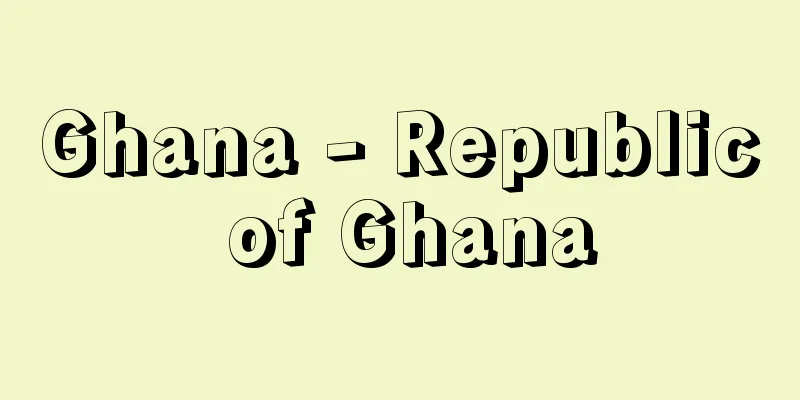
|
A republic in West Africa facing the Gulf of Guinea to the south. Its official name is the Republic of Ghana. It borders Togo to the east, Burkina Faso to the north, and Côte d'Ivoire to the west. Its area is 238,537 square kilometers, about two-thirds the size of Japan, with a population of 24.22 million (2010 census) and a population density of 102 people per square kilometer. Its capital is Accra, with a population of 2.342 million (2010 estimate). It is a member of the Commonwealth of Nations. [Hiromitsu Nakamura and Tsutomu Takane] NatureThe country is shaped like a long, narrow rectangle running north to south, with the Volta River flowing through the center and the Volta River Basin running from the center to the east. In 1966, the Akosombo Dam was constructed, creating Lake Volta, the world's largest man-made lake. The coastal areas are covered with hot and humid tropical rainforests, while the northern inland areas are covered with savanna and steppe. The Kwafu Plateau in the southwest is a tropical rainforest area and is a major producer of cocoa and forest products. The capital, Accra, is located on the coast, but it is in the savannah area and is dry with little rainfall. [Hiromitsu Nakamura and Tsutomu Takane] historyAt the end of the 15th century, the Portuguese built a fort in Elmina, west of Cape Coast, and traded in gold and slaves, so the area was called the Gold Coast. In the 18th century, the Ashanti Kingdom had become powerful inland, but there were many small states along the coast. Following Portugal, Spain, Britain, the Netherlands, and Denmark built forts along the coast and traded gold and slaves thrived. In 1874, Britain established the southern coastal area as the Gold Coast Colony, and fought three wars with the inland Ashanti Kingdom. In 1900, Britain annexed the Ashanti Kingdom and the northern region as a protectorate, and the entire Ghana area became a British colony and protectorate. However, British policies caused opposition from the indigenous Africans, and the Aborigines' Rights Protection Society (ARPS) was organized in 1897 before annexation. The African nationalist movement was promoted by the elites who had received European education and traditional chiefs, and in 1920 the first meeting of the National Congress of British West Africa (NCBWA) was held in Accra, attended by 40 people from the Gold Coast. The National Congress demanded that the British should Africanize the civil service and promote education. In the 1930s the Gold Coast Youth Congress was formed, and students and young people began to participate in the nationalist movement. The Second World War also had a major impact on the economy and politics of the Gold Coast, and in August 1947 the United Gold Coast Convention (UGCC) was organized under the leadership of Joseph Danquah (1895-1965), with Nkrumah becoming its full-time secretary-general in December. However, Nkrumah and the students and young people opposed the moderate actions of the other UGCC leaders and organized the Convention People's Party (CPP) in June 1949 to promote the liberation movement. In 1951, the CPP won an overwhelming victory in the self-governing assembly election proposed by the British, and Nkrumah became prime minister. On March 6, 1957, the independent state of Ghana (which inherited the name of the ancient Kingdom of Ghana that flourished in what is now the Mali region) was born, including the United Nations Trust Territory of Togoland, and in July 1960, it became a republic (the Republic of Ghana) as a member of the Commonwealth of Nations, with Nkrumah inaugurated as its first president. Nkrumah promoted active foreign and domestic policies based on Pan-Africanism and socialism, but economic collapse and growing dissatisfaction with one-party rule led to the collapse of the Nkrumah government in a military coup in February 1966 while Nkrumah was visiting China. The military government implemented fiscal austerity measures, banned one-party rule in order to restore civilian rule, and promulgated a new constitution in August 1969 that divided the powers of the president and prime minister, and held a general election. The election was won by the Progress Party (PP) of Kofi Abrefa Busia (1913-1978), restoring civilian rule. However, even under Busia's administration, the economic situation worsened due to a combination of poor cocoa harvests, rising inflation, and the depreciation of the cedi. In January 1972, Colonel Ignatius Kutu Acheampong (1931-1979) seized power in a coup. The Acheampong administration promoted policies such as restoring the country's first president, Nkrumah, as a leader of the Pan-Africanist and national liberation movement, restoring relations with China and the Soviet Union, and maintaining friendly relations with European countries. However, inflation, food shortages, and shortages of daily necessities in urban areas continued. In January 1979, the formation of political parties was liberalized, and a general election was scheduled for June of the same year, but just before that, a coup was carried out by Air Force officer Jerry John Rawlings (1947-2020), and Acheampong and others were publicly executed for fraud and corruption. The general election was held as scheduled, with the People's National Party (PNP) winning roughly half of the seats, defeating the Busia-affiliated Popular Front Party (PFP), and Hilla Limann (1934-1998) of the PNP being elected president. Civilian rule was restored on September 24, but the economic situation continued to deteriorate, and in December 1981 Rawlings again staged a coup, becoming head of state and chairman of the Provisional National Defense Council (PNDC). [Hiromitsu Nakamura and Tsutomu Takane] Politics and DiplomacyRawlings worked with the World Bank and the International Monetary Fund (IMF) to introduce the Economic Recovery Programme (ERP) to prevent corruption and restore the production base. At the same time, he aimed to democratize the political decision-making process, and in March 1982 he established the People's Defence Committee (PDC) to encourage people's participation and to create a new government system. In December 1984, the PDC was reorganized as the Committee for the Defence of the Revolution (CDR), and local council elections were held in 1987-1988, furthering democratization. In 1990, in response to calls for an end to the ban on political activities within the country and to democratization as a condition for continued aid from donor countries and agencies, the National Commission for Democracy (NCD) was formed and a series of discussions were held on Ghana's future and political and economic future. However, in August 1990, the newly formed Movement for Freedom and Justice (MFJ) criticized the NCD for being too close to the PNDC. On December 30, 1990, Rawlings announced a proposal to "set a new constitution by the end of 1991" and in March 1991, he submitted a report on the process towards democracy. In May 1991, the PNDC approved a return to a multi-party system and an advisory council was formed to discuss a draft constitution prepared by government-appointed constitutional experts. The draft constitution was approved by the Consultative Assembly at the end of March 1992, and was adopted in a national referendum held on April 28 of the same year, with a turnout of 43.7% and 92% of the votes in favor. In July 1992, numerous political organizations (political parties) were born, and six opposition groups were recognized as legal. In the same month, the National Democratic Congress (NDC) replaced the PNDC as the organization (political party) that would run in the elections as the ruling party representative. In August, it was decided that if a candidate did not receive more than 50% of the votes in the presidential election, a runoff election would be held between the candidate and the second-place candidate. In September 1992, Rawlings retired from the military in accordance with the new constitution and was nominated as the NDC's presidential candidate. In the presidential elections held as scheduled on November 3, 1992, Rawlings won 58.3% of the vote, Albert Adu Boahen of the New Patriotic Party (NPP) won 30.4%, and former president Hilla Liman of the People's National Convention (PNC) won 6.7%. Commonwealth election observers reported that the election was free and fair. However, opposition groups, including the NPP, attacked the election, alleging widespread electoral fraud, and anti-government riots broke out in Kumasi, Boahen's base in the Ashanti region, leading to a night-time curfew. On November 13, opposition groups decided to boycott the parliamentary elections until a new electoral register was submitted. In the parliamentary elections on December 29, the NDC won all but two of the 200 seats up for grabs. The Rawlings administration was inaugurated in January 1993 with an overwhelming majority in parliament. Meanwhile, the opposition groups NPP, PNC, National Independence Party (NIP), and People's Heritage Party (PHP) established the Inter-Party Coordinating Committee (ICC), which declared that they would act as an official opposition party to the government, even though they had no power in parliament, and launched a fierce attack on the budget proposal, which they deemed to have been drawn up under the auspices of the World Bank and IMF. On December 7, 1996, presidential and parliamentary elections were held. Rawlings won 57.2% of the votes in the presidential election, defeating John Agyekum Kufuor (1938- ), the candidate of the "grand alliance" of the NPP and the People's Convention Party (PCP), who only won 39.9%. The NDC also won an overwhelming victory in the parliamentary election, winning 133 of the 200 seats. The NPP won only 60 seats. Rawlings was inaugurated as president for a second term in January 1997. In the presidential election in December 2000, Rawlings did not run in accordance with the constitution's prohibition on a third consecutive term, and NPP leader Kufuor was elected as the new president (taking office the following January 2001). The NPP also became the leading party in the parliamentary election, making this a groundbreaking election in which a change of power between the ruling and opposition parties was realized for the first time since independence. In the presidential elections held in December 2004, Kufuor was re-elected (and took office in January 2005), and in the parliamentary elections the NPP won a majority, 128 of the 230 seats. In the December 2008 presidential election, Nana Akufo-Addo (1944- ) ran for the NPP in place of Kufuor, who was barred from running due to constitutional regulations, while John Evans Atta Mills (1944-2012), who had been vice president under Rawlings as president, ran for the NDC, the largest opposition party. As a result of the runoff election, Mills received 50.23% of the vote, slightly more than Akufo-Addo's 49.77%, and Mills became president, realizing the second change in ruling party and opposition party in eight years. In the parliamentary elections, the NDC won 115 seats, half of the total 230 seats. In July 2012, President Mills suddenly died, and Vice President Mahama became president. The presidential election will be held in December 2012. The parliament is unicameral, with 230 seats as of 2012. The term of office for members is four years. The president is elected by direct popular vote, and serves a four-year term. Three consecutive terms are prohibited. The military is volunteer-only, with a total strength of 15,500 (11,500 in the Army, 2,000 in the Navy, and 2,000 in the Air Force) (2009). Foreign policy during the Nkrumah era emphasized pan-Africanism and anti-colonialism, and maintained friendly relations with socialist countries. The military regime also adopted a similar non-aligned approach, but the Busia administration expressed a pro-Western non-aligned approach. The Rawlings administration maintained diplomatic relations with Libya and kept close ties with the Sankara administration in neighboring Burkina Faso. Relations with neighboring Togo were fraught with conflict over anti-government activities and smuggling by exiles from both countries, and the border was often closed. However, in July 1995, Togo's President Gnassingbé Eyadéma (1937-2005) and Rawlings signed an agreement to establish a bilateral committee on economic, social and technical cooperation and a Ghana-Togo border committee, and diplomatic relations were normalized. Attacks by Ghanaians on Ivorian soccer players and supporters in November 1993 led to retaliation against Ghanaians in Ivory Coast, leaving 25 people dead. However, relations between the two countries improved following the formation of a joint commission to investigate the violence in December. In response to the Liberian civil war that broke out at the end of 1989, the Economic Community of West African States (ECOWAS) dispatched a monitoring force (ECOMOG: ECOWAS Monitoring Group) in August 1990, with approximately 1,000 Ghanaian troops participating. In September 1994, ECOWAS, chaired by Rawlings, held discussions to end the civil war and restore civilian rule in Liberia, deciding on the term of the Transitional National Council, presidential elections, and other matters. Its first president, Nkrumah, was a promoter of the Organisation of African Unity, which was established in 1963 (reorganised into the African Union in July 2002), and Ghana also joined ECOWAS, which was established in 1975. In terms of relations with its former colonial power, the United Kingdom, Ghana continues to maintain its status as a member of the Commonwealth of Nations. English is the official language, and exchanges are maintained in the fields of education, culture, sports and law. Ghana also enjoys good relations with major developed countries, with US President Obama visiting Ghana in 2009 and Japan's Emperor Akihito visiting Ghana in 2010. [Hiromitsu Nakamura and Tsutomu Takane] Economy and IndustryAt the time of independence in the late 1950s, Ghana's economy was at the highest level among neighboring West African countries. However, economic activity declined rapidly thereafter. The per capita gross national product (GNP) growth rate for the 20 years from 1965 to 1984 was minus 1.9% per year, and the inflation rate reached 52.2% from 1973 to 1984. The per capita food production index, which was 100 for 1974 to 1976, fell to 73 for 1982 to 1984. The main food crops were rice, beans, pearl millet, sorghum, cassava, and yams, but the country constantly imported food and relied on international aid during droughts. From the mid-1980s onwards, the government promoted economic liberalization policies with generous financial assistance from major donor countries and international organizations, and the country's economic situation gradually improved. The gross national income (GNI) per capita in 2009 was $1,190. From independence until the early 1970s, Ghana was the world's largest cocoa producer and exporter, accounting for more than 50% of the world market. In the early 1960s, Ghana's annual production reached 566,000 tons, but gradually decreased, and in the late 1970s, Ghana lost its top spot in cocoa production to Côte d'Ivoire and Brazil, dropping to third place in the world. In the 1980s, it further dropped to the 200,000 tons range. During this period, due to a policy to keep producer prices low, about 50,000 tons were smuggled out to neighboring countries such as Côte d'Ivoire and Togo. Under the second Rawlings administration, the Economic Recovery Plans (ERP I and ERP II) were introduced in 1983 and 1987, and plans were made to reorganize the Cocoa Marketing Board (CMB), the monopoly purchasing organization, improve producer prices, develop pesticides and sprayers, and improve transportation and distribution services. Cocoa production then began to increase, recovering to 325,000 tons in 1995. In 2010, production was 632,037 tons. Cocoa produced by Ghanaian small farms was previously purchased in bulk through the CMB and exported, but since 1992, several licensed private companies have been purchasing cocoa domestically. However, government-affiliated companies are still responsible for most exports. The tropical rainforests in the southwestern region are rich in forest resources, and timber has been the second most important export item after cocoa since the 1960s. Subsequent resource conservation and low-price policies led to stagnant production and exports, but in 1985 the Forest Products Inspection Bureau and Timber Export Development Board were established, with the aim of gradually reducing log exports and promoting domestic lumber production. By 1991, timber (mainly domestic lumber products) had recovered to become the third most important export item after cocoa and gold. Timber production in 2003 was 22,078,000 cubic meters. The mining industry produces gold, diamonds, bauxite, and manganese. Gold is Ghana's main mineral export, replacing cocoa as the country's number one export in 1992. In 2004, Ghana produced 63.1 tonnes of gold ore, with the Tarkwa mine (17.2 tonnes) and Obuasi mine (11.9 tonnes) being the major gold mines. Obuasi mine is mined by Ashanti Goldfields Ltd., a company partially owned by the Ghanaian government. In 2003, it produced 1,603,821 ounces (about 45.5 tonnes) of gold. Diamonds are industrial diamonds, and production was 3.2 million carats in 1960, but fell to 300,000 carats in 1988. It then recovered to about 700,000 carats in 1993 and about 800,000 carats in 1995. Production in 2002 was 1,161,000 carats (about 232.2 kilograms). Ghana has significant bauxite reserves, but the deterioration of the railroad facilities linking the port of Takoradi with Awoso caused exports to fall to 30,000 tonnes, but as facilities improved exports rose to 170,000 tonnes in 1985, 400,000 tonnes in 1991, and 569,800 tonnes in 2004. As of 2004, Ghana's manganese production was 1,597,100 tonnes, making it the ninth largest producer in the world. The country's main manganese mines, located in Nsta, Western Province, are mined by the Ghana Manganese Company, which was privatized from a state-owned enterprise in 1996. In 2007, new oil reserves were discovered off the western coast of Ghana, and commercial production began in 2010. The oil field, named Jubilee, is being jointly developed by British and American companies. Ghana has the Akosombo Hydroelectric Power Station and the Pon Hydroelectric Power Station, which were constructed under the Volta River Development Programme, and electricity from these hydroelectric power stations meets the domestic electricity demand and is also exported to Togo, Benin, etc. In 2010, the total electricity generation was about 10.06 million gigawatts, of which 59% was from the Akosombo Hydroelectric Power Station. Looking at the trade structure by product (2010), the main export items are gold (48%), cocoa (28%), and timber (9%), while the main import items are industrial products (55%) and food products (37%), resulting in a chronic trade deficit. The main import partners are the United States (13%), China (12%), and Nigeria (6%), while the main export partners are South Africa (52%), the Netherlands (5%), and the United Kingdom (3%). The currency is the Ghanaian cedi. [Hiromitsu Nakamura and Tsutomu Takane] Society and CultureThe population growth rate is 3.0% per year, about twice the world average, and 35.4% of the total population lives in cities. The estimated population of the major cities in 2001 was Accra (1,551,200; in 2010 it was 2,342,000), Kumasi (610,600), Tamale (259,200), and Tema (225,900). There is a significant movement of labor from rural to urban areas, which is worsening employment, food, and the supply of daily necessities in urban areas, promoting inflation, and becoming a source of social unrest. According to a 1998 census, the ethnic composition of the population is Akan (44%), Mossi-Dagomba (16%), Ewe (13%), Ga (8%), Gurma (3%), Yoruba (1%), other ethnicities (1.5%), as well as Europeans and Arabs. More than 75 languages are spoken in the country, but the official language is English, and eight major languages are officially recognized and used in education, broadcasting, etc. The southern coastal region, which had a long period of contact with Europeans, was colonized early and introduced Christianity and European-style education, and the northern region, where traditional lifestyles remain deeply rooted and change has been relatively small, have differences and conflicts in cultural and political aspects, but ethnic conflict has not surfaced.However, in 1994, clashes occurred in Nanumba, northern province, between the Konkoba people, who had migrated from Togo, and the local Nanumba people. In terms of religion, the country has the highest proportion of Christians among West African countries, accounting for 62.6% (Protestant 27.9%, Catholic 18.7%, indigenous African Christian 16.0%), while Muslims make up just 15.7%. Education was promoted by various Christian missionaries during the colonial period, and Ghana had the highest education penetration rate in Africa. In 1961, the first compulsory education system in Africa was introduced. In higher education, there are the University of Ghana (Accra), which was established as a college in 1948 and became a comprehensive university in 1961, the University of Science and Technology (Kumasi), which was established as a technical college in 1952 and became a university in 1962, the University of Cape Coast, which was established in the same year, and the University of Development Studies (Tamale), which was established in 1992. The number of university students in 1994-1995 was 11,125. The literacy rate for those aged 15 and over is relatively high, at 82.7% for men and 67.1% for women (2003). Major daily newspapers include the Daily Telegraphic (100,000 copies, state-run) and the Ghanaian Times (40,000 copies, state-run). The "Forts of the Volta, Greater Accra, Central and Western Regions" were registered as UNESCO World Heritage Sites (cultural heritage) in 1979, and the "Ashanti Traditional Buildings" in 1980. [Hiromitsu Nakamura and Tsutomu Takane] Relations with JapanJapan recognized Ghana at the same time as its independence in 1957 (Showa 32) and established diplomatic relations with the country, opening a Japanese embassy in Accra in 1959. In 1960, a Ghanaian embassy was opened in Tokyo. Ghana has received economic cooperation from Japan in the form of grant aid and yen loans, including the construction of the Noguchi Memorial Institute for Medical Research at the University of Ghana. In 2009 (Heisei 21), exports to Japan amounted to approximately 122 million dollars, mainly cocoa beans, and imports of approximately 103 million dollars, mainly automobiles. In March 2001, Ghana applied for the Enhanced HIPC (Heavily Indebted Poor Countries - countries suffering from poverty due to large accumulated debts that are difficult to repay) Initiative, and in July 2004, it met the criteria for judgment and completion, reaching the completion point, and in December of the same year, Japan waived its Official Development Assistance (ODA) credit to Ghana of 104,678 million yen. Japan's cumulative aid performance up to fiscal year 2009 is 125,091 million yen in loan aid (including the 104,678 million yen credit waived by Japan under the above HIPC Initiative), 85,259 million yen in grant aid, and 42,091 million yen in technical cooperation. In addition, the number of trainees accepted from Ghana to Japan up to fiscal year 2009 was 2,449, and the number of experts and Japan Overseas Cooperation Volunteers dispatched from Japan to Ghana was 1,929. [Hiromitsu Nakamura and Tsutomu Takane] "Agriculture and Farmers in Africa: A Case Study of Ghana" by Hosomi Shinya (1992, Dobunkan Publishing)" ▽ "Food Problems in Africa: The Cases of Ghana, Nigeria, and Tanzania" by Hosomi Shinya, Shimada Shuhei, and Ikeno Jun (1996, Institute of Developing Economies)" ▽ "Developing Country Economic Cooperation Series: Africa 10, Ghana, 4th Edition (1998, Japan Association for Promotion of International Cooperation)" ▽ "Cocoa Farmers in Ghana: The Social Aspects of Small Scale Export Crop Production" by Takane Tsutomu (1999, Institute of Developing Economies, Japan External Trade Organization)" ▽ "Eyes to Asia 104: Ghana: A Country of Chaos and Hope" by Takane Tsutomu (2003, Institute of Developing Economies, Japan External Trade Organization)" ▽ "47 Chapters to Understand Ghana" edited by Takane Tsutomu and Yamada Shoko (2011, Akashi Shoten) [References] | | | | | | | | | | | | | | | | | [Additional resources] |"> Ghana flag ©Shogakukan Illustration/Shogakukan Creative "> Ghana Location Map Source: Shogakukan Encyclopedia Nipponica About Encyclopedia Nipponica Information | Legend |
|
西アフリカ、ギニア湾に南面する共和国。正式名称はガーナ共和国Republic of Ghana。東はトーゴ、北はブルキナ・ファソ、西はコートジボワールと国境を接する。面積23万8537平方キロメートルで日本の約3分の2、人口2422万(2010年センサス)、人口密度1平方キロメートル当り102人。首都はアクラ、人口234万2000(2010年推計)。イギリス連邦加盟国。 [中村弘光・高根 務] 自然国土は南北に細長い長方形をなし、中央部にボルタ川が流れ、中央部から東はボルタ川流域盆地となっている。1966年にアコソンボ・ダムが建設され、世界最大の人造湖ボルタ湖が誕生した。海岸地帯には高温多湿な熱帯雨林地帯があるが、北部の内陸部はサバンナ、ステップ地帯が広がっている。南西部のクワフ高原は熱帯雨林地帯で、カカオおよび林産物の主要な産地である。首都アクラは沿岸地帯にあるが、サバンナ地帯に属し雨量は少なく乾燥している。 [中村弘光・高根 務] 歴史15世紀末、ポルトガル人がケープ・コーストの西にあったエルミナに城塞(じょうさい)を築き、金と奴隷の貿易を行ったことから、その一帯は、黄金海岸(ゴールド・コースト)とよばれた。内陸部では18世紀にアシャンティ王国が強大になっていたが、海岸地帯には小国家が多数存在した。ポルトガルに続いて、スペイン、イギリス、オランダ、デンマークが海岸地帯に要塞を築き、金と奴隷の貿易が盛んに行われた。1874年に南部海岸地帯をゴールド・コースト植民地としたイギリスは、内陸部のアシャンティ王国との三次にわたる戦争を重ね、1900年にアシャンティ王国と北部地域を保護領として併合、現在のガーナ全域がイギリス領植民地および保護領となった。 しかし、イギリスの政策は先住アフリカ人の反発を招き、併合前の1897年に先住民権利保護協会(ARPS:Aborigines' Rights Protection Society)が組織された。アフリカ人による民族主義運動はヨーロッパ型教育を受けたエリート層と伝統的首長層によって推進され、1920年にはイギリス領西アフリカ国民会議(NCBWA:National Congress of British West Africa)の第1回会議をアクラで開催、ゴールド・コーストから40名が出席した。国民会議はイギリスに対して官吏制度のアフリカ人化、教育の普及を要求した。1930年代にはゴールド・コースト青年会議が結成され、学生・青年層が民族主義運動に参加し始めた。第二次世界大戦はゴールド・コーストの経済、政治にも大きな影響を与え、1947年8月、ダンカーJoseph Danquah(1895―1965)を中心に統一ゴールド・コースト会議(UGCC:United Gold Coast Convention)が組織され、12月にはエンクルマが専任の書記長になった。しかし、エンクルマや学生・青年層は他のUGCC指導部の穏健な行動に反対して、1949年6月に会議人民党(CPP:Convention People's Party)を組織して解放運動を推進した。そして1951年イギリスの提案した自治政府議会選挙でCPPが圧倒的勝利を獲得し、エンクルマが首相に就任した。 1957年3月6日、国連(国際連合)信託統治領トーゴランドを含めて、独立国ガーナ(現在のマリ地域に栄えた古代ガーナ王国の名称を継承)が誕生、1960年7月にコモンウェルス(イギリス連邦)の一員として共和国(ガーナ共和国)に移行、エンクルマが初代大統領に就任した。エンクルマは汎(はん)アフリカ主義と社会主義とに基づいて積極的な外交・内政政策を推進したが、経済的破綻(はたん)のうえに一党制支配に対する不満が強まり、エンクルマが中国訪問中の1966年2月、軍部クーデターによってエンクルマ政権は崩壊した。軍部政権は財政緊縮政策をとり、民政復帰のために一党制支配を禁止し、大統領と首相の権限を分割した新憲法を1969年8月に発布、総選挙を実施した。選挙ではブシアKofi Abrefa Busia(1913―1978)の進歩党(PP:Progress Party)が勝利し民政が復活した。しかし、ブシア政権下でも、カカオの不作、インフレーションの進行、通貨セディの下落などが重なり経済状況は悪化した。 1972年1月アチャンポンIgnatius Kutu Acheampong(1931―1979)大佐がクーデターで実権を握った。アチャンポン政権は、初代大統領エンクルマを汎アフリカ主義、民族解放運動指導者として復権させ、中国、ソ連との関係を復活、ヨーロッパ諸国との友好関係も維持させるなどの政策を推進した。しかし都市部におけるインフレーション、食糧不足、生活必需品不足の状態は続いた。1979年1月に政党結成が自由化され、同年6月に総選挙が予定されたが、その直前、空軍将校ジェリー・ローリングスJerry John Rawlings(1947―2020)によるクーデターが発生し、アチャンポンらは不正、腐敗を理由に公開処刑された。総選挙は予定どおり実施され、人民国家党(PNP:People's National Party)が約半数の議席を占めて、ブシア系の人民戦線党(PFP:Popular Front Party)を破り、大統領選挙ではPNPのヒラ・リマンHilla Limann(1934―1998)が選出された。9月24日には民政が復活したが、経済情勢の悪化は続き、1981年12月ふたたびローリングスによるクーデターが発生、ローリングスが国家元首、暫定国家防衛評議会(PNDC:Provisional National Defence Council)議長に就任した。 [中村弘光・高根 務] 政治・外交ローリングスは、世界銀行・国際通貨基金(IMF)と協力し、経済復興プログラム(ERP:Economic Recovery Programme)を導入して、腐敗の防止、生産基盤の回復を図った。一方、政治決定過程の民主化を目ざし、1982年3月に人民防衛委員会(PDC:People's Defence Committee)を設定して人民参加を促し、新政府の体制づくりが意図された。PDCは1984年12月に革命防衛委員会(CDR:Committee for the Defence of the Revolution)に改組、1987~1988年に地方議会選挙を行い、「民主化」を進めた。 1990年には国内からの政治活動禁止の終結への要望、援助提供国・機関からの援助継続条件としての民主化の要求に応じて、民主主義全国委員会(NCD:National Commission for Democracy)が組織され、ガーナの将来および政治・経済について一連の討議が進められた。しかし、1990年8月に新たに結成された自由・正義運動(MFJ:Movement for Freedom and Justice)は、NCDがPNDCと非常に近いことを批判した。ローリングスは1990年12月30日、「1991年末までに新憲法を設定する」という提案を発表、1991年3月には、民主主義への過程についての報告を提出した。1991年5月には、PNDCが複数政党制への復帰を承認、政府任命の憲法専門家によって作成された憲法草案を討議する諮問会議が組織された。1992年3月末に憲法草案は諮問会議によって承認され、同年4月28日に実施された国民投票によって、43.7%の投票率、投票数の92%の賛成票を得て採択された。1992年7月、数多くの政治組織(政党)が誕生し、野党グループ6党が合法と認められた。同月に、国家民主会議(NDC:National Democratic Congress)がPNDCに代わって、与党派代表として選挙に出る組織(政党)となった。8月には大統領選挙で、候補者が50%以上の投票を獲得しない場合、2位の候補との間で決選投票が実施されることが決められた。 1992年9月、ローリングスは新憲法に従って軍隊を退役し、NDCの大統領候補として指名された。1992年11月3日に予定通り実施された大統領選挙では、ローリングスが58.3%、新愛国党(NPP:New Patriotic Party)のアドゥ・ボアヘンAlbert Adu Boahenが30.4%、元大統領で人民国家会議(PNC:People's National Convention)のヒラ・リマンが6.7%を獲得した。イギリス連邦の選挙監視団は、選挙が自由・公正の下に行われたと報告した。しかし、NPPをはじめとする野党グループは、広範に選挙不正があったと攻撃、ボアヘンの地盤であるアシャンティ州のクマシでは反政府暴動が起こり、夜間外出禁止の措置がとられた。11月13日、野党グループは新選挙人登録簿が提出されるまで議会選挙をボイコットすることを決定した。12月29日の議会選挙では、総議席200のうち、2議席を除く全議席をNDCが獲得した。 1993年1月、ローリングス政権が議会勢力の圧倒的多数を占める形で発足した。一方、野党グループのNPP、PNC、国民独立党(NIP:National Independence Party)、人民遺産党(PHP:People's Heritage Party)は政党間調整委員会(ICC:Inter-Party Coordinating Committee)を発足させ、議会内に勢力をもたないが政府に対する正式の野党として活動することを表明、世界銀行・IMFの下で策定されたとみなされる予算案に対し激しく攻撃した。 1996年12月7日、大統領選挙および国会議員選挙が実施され、大統領選挙ではローリングスが57.2%の票を獲得し、39.9%の得票にとどまったNPPと人民会議党(PCP:People's Convention Party)の「大同盟」による候補クフォーJohn Agyekum Kufuor(1938― )を破った。国会議員選挙でもNDCが200議席中133議席を獲得し、圧倒的勝利を収めた。NPPの議席は60議席にとどまった。ローリングスは1997年1月に2期目の大統領に就任した。2000年12月の大統領選挙では、ローリングスは連続3選禁止を定めた憲法に従って出馬せず、NPP党首クフォーが新大統領に当選(翌2001年1月就任)。国会議員選挙でもNPPが第1党となるなど、独立後初めて選挙に基づく与野党間の政権交代が実現した画期的な選挙であった。2004年12月の大統領選挙ではクフォーが再選を果たし(翌2005年1月就任)、国会議員選挙ではNPPが230議席中128議席と、過半数を獲得した。 2008年12月の大統領選挙では、憲法の規定により出馬できないクフォーにかわってNPPからはアクフォ・アドゥNana Akufo-Addo(1944― )が立候補し、最大野党NDCからはローリングスの大統領時代に副大統領であったミルズJohn Evans Atta Mills(1944―2012)が出馬した。決選投票の結果、ミルズの得票率が50.23%でアクフォ・アドゥの49.77%をわずかに上回り、ミルズが大統領となって8年ぶり2回目の与野党交代が実現した。国会議員選挙でもNDCは115議席と全議席230の半数を獲得した。2012年7月、大統領ミルズが急死し、副大統領のマハマが大統領に就任した。2012年12月には大統領選挙が行われる。 議会は一院制で、2012年時点で議席数は230。議員の任期は4年。大統領は国民の直接選挙で選ばれ、任期は4年。連続3選は禁止。 軍隊は志願兵制で、総兵力1万5500(陸軍1万1500、海軍2000、空軍2000)である(2009)。 エンクルマ時代の外交政策は、汎アフリカ主義、反植民地主義を強調し、社会主義諸国との友好関係を維持していた。軍事政権時代もほぼ同様の非同盟主義をとっていたが、ブシア政権は親西欧的非同盟主義を表明した。ローリングス政権はリビアとの外交関係を維持し、近隣のブルキナ・ファソのサンカラ政権と緊密な関係を保った。隣国トーゴとの関係は両国の亡命者による反政府活動、密貿易をめぐって対立し、しばしば国境が閉鎖されたが、1995年7月、トーゴ大統領エヤデマGnassingbé Eyadéma(1937―2005)とローリングスとの間で、経済・社会・技術協力二国間委員会および、ガーナ・トーゴ国境策定委員会の設置について協定が結ばれ、外交関係は正常化した。1993年11月に起こったガーナ人によるコートジボワールのサッカー選手、サポーターに対する攻撃事件はコートジボワール国内に在留するガーナ人に対する報復活動を招き、死者は25人に及んだ。しかし、12月の暴力調査共同委員会の結成に伴い、両国間の関係は改善された。 1989年末に始まったリベリア内戦に対して、1990年8月に西アフリカ諸国経済共同体(ECOWAS:Economic Community of West African States)は監視軍(ECOMOG:ECOWAS Monitoring Group)を派遣し、約1000人のガーナ軍がこれに参加した。1994年9月、ローリングスが議長を務めていたECOWASはリベリアの内戦終結、民政復帰のために協議し、暫定国家評議会の任期、大統領選挙などについて決定した。 初代大統領のエンクルマは1963年に成立したアフリカ統一機構(2002年7月アフリカ連合に改組)の推進者であり、ガーナは1975年に成立したECOWASにも成立時に加盟している。旧宗主国イギリスとの関係では、イギリス連邦の構成員としての地位を保持し続けている。英語を公用語としており、教育、文化、スポーツ、法律の諸分野における交流関係も維持されている。また2009年にはアメリカ大統領のオバマが、2010年には日本の明仁(あきひと)天皇が相次いでガーナを訪問するなど、主要先進国との関係は良好である。 [中村弘光・高根 務] 経済・産業1950年代後半、独立当時のガーナ経済は、近隣の西アフリカ諸国のなかで最高の水準に達していた。しかし、その後の経済活動は急速に低下した。1965~1984年の20年間の1人当り国民総生産(GNP)成長率は年率マイナス1.9%を記録し、1973~1984年のインフレーション率は52.2%に達した。1人当り食糧生産指数は1974~1976年を100として1982~1984年には73まで低下した。主要食料作物は米、豆類、トウジンビエ(イネ科の雑穀)、モロコシ、キャッサバ、ヤム(ヤムイモ)などであるが、常時食料を輸入し、干魃(かんばつ)時には国際援助に依存していた。1980年代なかば以降、政府は主要援助国や国際機関からの手厚い資金援助を得て経済自由化政策を推進し、国内の経済状況は次第に好転した。2009年の1人当り国民総所得(GNI)は1190ドルである。 独立期から1970年代前半期まで、ガーナは世界最大のカカオ生産国・輸出国であり、世界市場の50%以上を占めていた。1960年代前半期には年産56万6000トンに達したが徐々に減少し、1970年代後半期にはカカオ生産量の首位の座をコートジボワールやブラジルに譲り、世界第3位に転落した。さらに1980年代には20万トン台にまで低下した。この時期はカカオ生産者価格を低く抑える政策のため、約5万トンがコートジボワールやトーゴなどの近隣諸国に密輸出されたとされている。第二次ローリングス政権下の1983年、1987年には経済復興計画(ERP Ⅰ・ERP Ⅱ)が導入され、独占的買付機構カカオ・マーケティング・ボード(CMB:Cocoa Marketing Board)の改編、生産者価格の改善、殺虫剤および噴霧器の開発、運輸・流通サービス等の改善計画が進められた。その後、カカオ生産量は増加に転じ、1995年には32万5000トンまで復活した。2010年の生産量は63万2037トンとなっている。ガーナ人の小規模農場で生産されるカカオは、CMBを通じて一括して買い上げられて輸出されていたが、1992年からは許可された複数の民間企業が国内買付けを行うようになった。ただし輸出に関しては、政府系企業がそのほとんどを担っている。 南西部の熱帯雨林地帯は豊富な森林資源があり、木材は1960年代以降、カカオに次ぐ重要な輸出品であった。その後の資源保護政策、低価格政策などによって生産・輸出は停滞したが、1985年には森林製品検査所Forest Products Inspection Bureau・木材輸出開発ボードTimber Export Development Boardが設置され、原木輸出の漸減ならびに国内での製材の促進を図っている。1991年には、木材(主に国内製材品)はカカオ、金に次いで第三の輸出品目に回復した。2003年の木材の生産量は2207万8000立方メートルとなっている。 鉱業では金、ダイヤモンド、ボーキサイト、マンガンを産出する。金はガーナの主要鉱産輸出品であり、1992年にはカカオに代わって輸出産品の第1位になった。2004年のガーナの金鉱石の生産量は63.1トンで、タルクワ鉱山(17.2トン)、オブアシ鉱山(11.9トン)が代表的な金鉱山となっている。オブアシ鉱山は、ガーナ政府が株式の一部を所有しているアシャンティ・ゴールドフィールズ社が採掘にあたっている。2003年には160万3821オンス(約45.5トン)の金を生産した。 ダイヤモンドは工業用ダイヤモンドで、1960年には320万カラットが生産されていたが、1988年には30万カラットまで低下した。その後1993年には約70万カラット、1995年には約80万カラットまで回復した。2002年の生産量は116万1000カラット(約232.2キログラム)である。 ガーナには相当量のボーキサイトが埋蔵されているが、タコラディの港湾施設とアウォソとを結ぶ鉄道施設の劣化によって、輸出量は3万トンにまで低下した。しかし施設の改善とともに、1985年には17万トン、1991年には40万トン、2004年には56万9800トンに増加した。 2004年時点でのガーナのマンガン生産量は159万7100トンで、世界第9位の産出国となっている。西部州ンスタにある主要なマンガン鉱は、1996年に国営企業から民営化されたガーナ・マンガン社によって採掘されている。 2007年にはガーナ西部の沿岸部で新たに石油の埋蔵が確認され、2010年から商業生産が開始された。この油田はジュビリー油田と名づけられ、イギリス系およびアメリカ系企業によって共同開発されている。 ガーナには、ボルタ川開発計画によって建設されたアコソンボ発電所と、ポン発電所があり、これらの水力発電所からの電力は国内の電力需要を満たすとともに、トーゴ、ベナンなどに輸出されている。2010年の発電量は約1006万ギガワットで、そのうちアコソンボ発電所からのものが59%を占めている。 商品別貿易構造(2010)をみると、おもな輸出品目は金(48%)、カカオ(28%)、木材(9%)、おもな輸入品目は工業製品(55%)、食料品(37%)となっており、慢性的な貿易赤字が続いている。おもな輸入相手国はアメリカ(13%)、中国(12%)、ナイジェリア(6%)など、おもな輸出相手国は南アフリカ(52%)、オランダ(5%)、イギリス(3%)などとなっている。通貨はガーナ・セディ。 [中村弘光・高根 務] 社会・文化人口増加率は年間3.0%で世界平均の約2倍と高く、全人口の35.4%が都市に居住している。2001年における主要都市の人口(推計値)はアクラ(155万1200。2010年には234万2000)、クマシ(61万0600)、タマレ(25万9200)、テマ(22万5900)である。農村から都市への労働力の移動が顕著であり、都市部における雇用、食糧、生活必需品供給を悪化させ、インフレーションを促進し、社会不安の根源となっている。 住民の民族集団別構成は、1998年の統計によれば、アカン人(44%)、モシ・ダゴンバ人(16%)、エウェ人(13%)、ガー人(8%)、グルマ人(3%)、ヨルバ人(1%)、その他の民族(1.5%)およびヨーロッパ人、アラブ人とされている。話しことばとしては、75以上の言語が使われているが、公用語は英語であり、八つの主要言語が公認の言語とされ、教育、放送などに利用されている。 ヨーロッパ人との接触の期間が長く、早くから植民地となり、キリスト教、ヨーロッパ型教育が導入された南部海岸地帯と、伝統的生活様式が根強く残り、変化が比較的小さい北部地帯とでは、文化面、政治面においても差異や対立がみられるが、いわゆる民族問題という対立関係は比較的表面化しなかった。しかし、1994年には、北部州ナヌンバにおいてトーゴから移住してきたコンコバ人と地元のナヌンバ人との衝突がみられた。 宗教は、西アフリカ諸国のなかではキリスト教徒の比率がもっとも高く、62.6%(プロテスタント27.9%、カトリック18.7%、アフリカ系土着キリスト教16.0%)を占め、イスラム教徒は15.7%にすぎない。 教育は植民地時代にキリスト教各派伝導団によって進められ、アフリカでもっとも教育普及率が高かった。1961年にはアフリカで最初の義務教育制度が導入された。高等教育では、1948年にカレッジ(単科大学)として設立され1961年に総合大学となったガーナ大学(アクラ)、1952年に技術カレッジとして設立され、1962年に大学となった科学・技術大学(クマシ)、同年に設立されたケープ・コースト大学、ならびに1992年に新設された開発研究大学(タマレ)などがある。1994~1995年における大学就学生数は1万1125人である。15歳以上の識字率は、男性82.7%、女性67.1%(2003)と比較的高い。主要日刊紙には、『デーリー・テレグラフィック』(10万部、国営)、『ガーナイアン・タイムズ』(4万部、国営)などがある。 ユネスコの世界遺産(文化遺産)として1979年に「ヴォルタ(ボルタ)州、グレーター・アクラ州、セントラル州、ウェスタン州の城塞群」が、1980年に「アシャンティの伝統的建築物群」が登録されている。 [中村弘光・高根 務] 日本との関係日本は1957年(昭和32)のガーナ独立と同時に承認して国交を結び、1959年にはアクラに日本大使館を開設。1960年には東京にガーナ大使館が開設された。日本からガーナ大学野口記念医学研究所建設など、無償および円借款による経済協力を受けている。2009年(平成21)の対日貿易は、輸出がカカオ豆を中心に約1億2200万ドル、輸入が自動車など約1億0300万ドルである。 2001年3月ガーナは拡大HIPC(重債務貧困国=返済が困難な多額の累積債務のために貧困に苦しんでいる国)イニシアティブへの適用を申請し、2004年7月には判断基準・完了基準を満たし、完了時点に到達したことから、日本は同年12月、ガーナに対する政府開発援助(ODA)債権1046億7800万円を放棄した。2009年度までの日本の累積援助実績は、有償資金協力1250億9100万円(上記HIPCイニシアティブによって日本が放棄した債権1046億7800万円も含まれている)、無償資金協力852億5900万円、技術協力420億9100万円となっている。また2009年度までのガーナから日本への研修員受入数は2449人、日本からガーナへの専門家および青年海外協力隊の派遣数は1929人となっている。 [中村弘光・高根 務] 『細見真也著『アフリカの農業と農民――ガーナの事例研究』(1992・同文舘出版)』▽『細見真也・島田周平・池野旬著『アフリカの食糧問題――ガーナ・ナイジェリア・タンザニアの事例』(1996・アジア経済研究所)』▽『『開発途上国国別経済協力シリーズ アフリカ編10 ガーナ』第4版(1998・国際協力推進協会)』▽『高根務著『ガーナのココア生産農民――小農輸出作物生産の社会的側面』(1999・日本貿易振興会アジア経済研究所)』▽『高根務著『アジアを見る眼104 ガーナ――混乱と希望の国』(2003・日本貿易振興会アジア経済研究所)』▽『高根務・山田肖子編著『ガーナを知るための47章』(2011・明石書店)』 [参照項目] | | | | | | | | | | | | | | | | | [補完資料] |"> ガーナの国旗 ©Shogakukan 作図/小学館クリエイティブ"> ガーナ位置図 出典 小学館 日本大百科全書(ニッポニカ)日本大百科全書(ニッポニカ)について 情報 | 凡例 |
Recommend
Schwarzschild - Karl Schwarzschild
German astronomer. He entered the University of S...
Estradiol - estradiol (English spelling)
It is a steroid hormone secreted from the ovaries...
Leo Kanner
1894‐1981 American child psychiatrist. Born in the...
Mamedzuta - Mamedzuta
An evergreen fern of the Polypodiaceae family. Al...
Stone-laying roof
A roof with stones placed on top of the shingles ...
National government office
The location of the provincial government office (...
Original - Honke
〘noun〙① The family line that is the main source. T...
Emperor Junnin
Year of death: Tenpyo Jingo 1.10.23 (765.11.10) Ye...
The Passion of Jesus Christ
…the story of Jesus Christ's Passion as recor...
Kan Chazan
Year of death: 1827.10.3 (Bunsei 10.8.13) Year of ...
Circle of Willis
This refers to the ring of arteries at the base o...
Fujii Uemon
A supporter of Imperial rule in the mid-Edo perio...
Atomic volume - Gensyou (English spelling)
This refers to the volume occupied by 1 mole of a...
verdict
…Jurors are paid travel expenses and daily allowa...
Honey buzzard (English spelling)
A bird of the order Accipitridae. It is a bird sim...
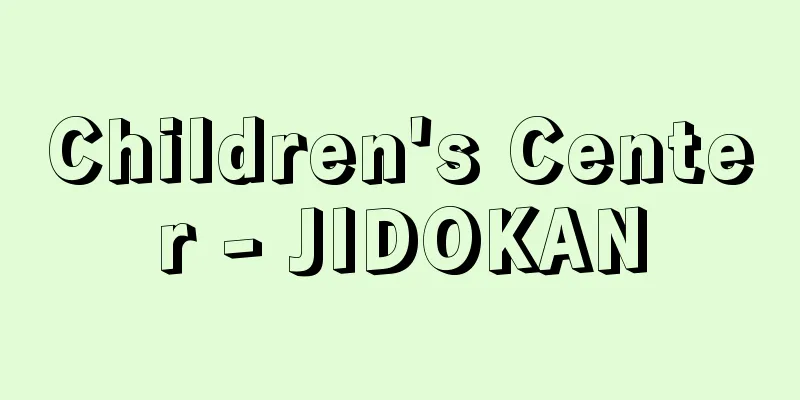
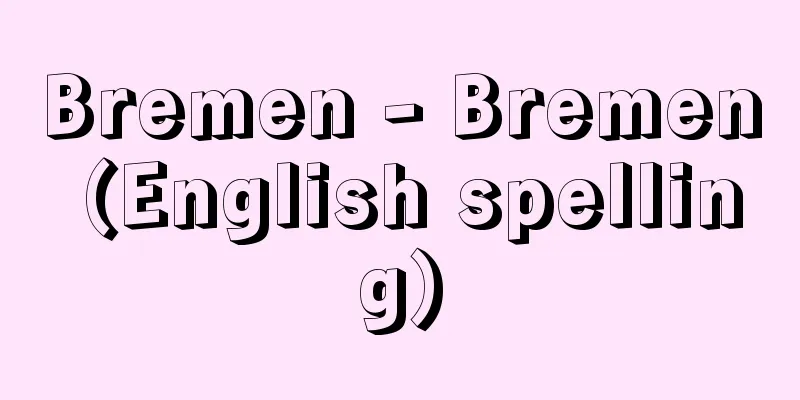


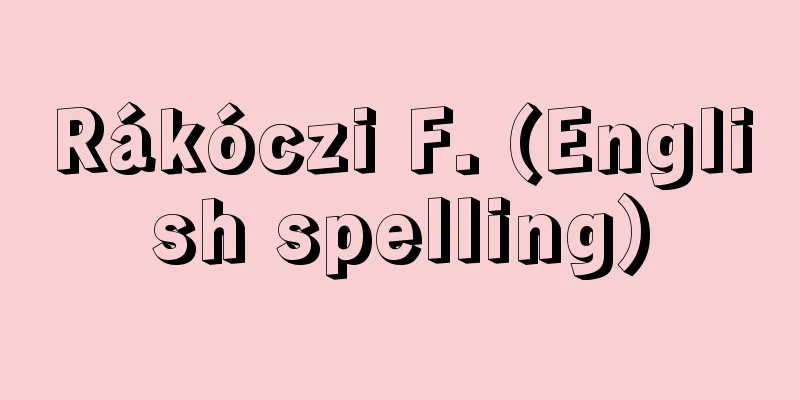
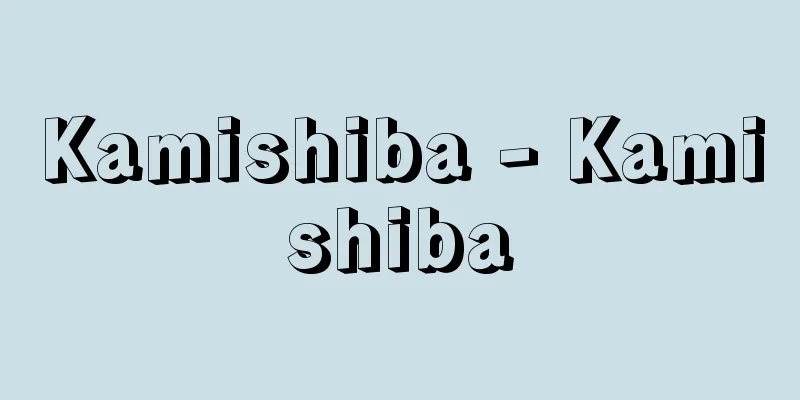


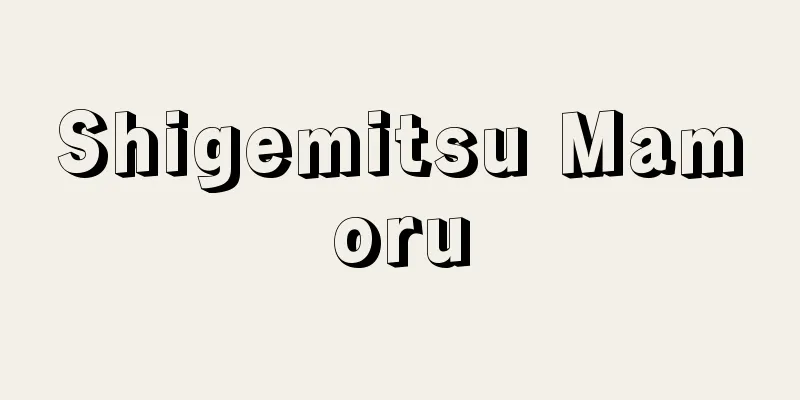
![Fujishima [town] - Fujishima](/upload/images/67ccb2882e759.webp)